I recently worked as a Facilitator and Team Leader at the Project Management and Leadership (PML) conference for Group 61 Volunteers and their Community Counterparts. The PML conference teaches very basic leadership skills (how to use an agenda, how to write a letter to an agency, how to speak about your project to others, how to run a meeting) to Panamanians. All of the participants are chosen for having demonstrated leadership potential in their community.
One evening during PML is Cultural Evening, with sharing of aspects of culture. Conference participants are told before they come that they will have a chance to share their culture with the group and thus come prepared with crafts and demonstrations planned. Several volunteers are serving in Ngöbe sites. The Ngöbe are an indigenous peoples living mostly in the Comarca Ngöbe Bugle, between Bocas del Toro, Chiriquí, and Veraguas. They shared, along with their volunteers, several of the dances from their culture.
Below are videos clips of a couple of the dances that they shared with us. In the videos notice the clothing...the women are wearing traditional nagua dresses. A nagua dress is characterized by the voluminous quantity of brightly colored material and the intricate hand sewn designs along the collar, sleeves, hem and waist. By brightly colored I mean teals, bright pinks, yellow, orange, reds, greens. I have occasionally seen naguas in pastels or patterned materials...but that is rare. I have been told that this style of dress dates back to the arrival of religious missionaries who taught the Ngöbe Bugle that it was better to dress modestly. Before that time the Ngöbe Bugle wore less covering clothing (cooler in this climate).
Thanks to Patrick for the videos, I did not have my camera in the room...so he shared with me.
Each dance has a specific name, just as each design on their dresses has a name...but the name for this on was in Ngöbera and it did not stick to my English -bound brain.
The above dance was called the Drunkard, and as I am writing this post on a day in the middle of carnival, I can say that there is some real resemblance to drunken dancing
The above dance, the only one executed in a circle, was called the Monkey. The volunteers that you see in the videos live in Ngöbe communities and were included just like all the Ngöbe Bugle in the room in the dance. It was pretty cool. I will be doing another PML seminar at the end of March...so I will look for more interesting culture to share with you.



1 comment:
Thank you, April, for sharing these videos and info on the Ngobe. My husband and I are sailboat cruisers currently in the Bocas del Toro area. We have fallen in love with the Ngobe people in their beautiful villages. So far we have visited Buena Esperanza, Shark Hole (Secretaridad), and Cristobal. Yesterday in Cristobal I bought a nagua at the Artisan Hut. Our Spanish is limited, so your info answered my questions. Thank you for giving of yourself generously to these native people of Panama. Best regards, Nancy @ montgomeryrb@gmail.com
Post a Comment